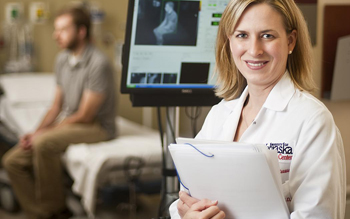Angela Hewlett, M.D., and her colleagues at UNMC found an infrared thermal detection system (ITDS) to be a fast and effective fever screening tool in clinical settings during the H1N1 influenza pandemic.
 |
Angela Hewlett, M.D. |
“This technology allows clinicians to rapidly screen people for fever, so that incoming patients and visitors who may be ill can be identified quickly and reduce the danger of spreading diseases,” said Dr. Hewlett, assistant professor of infectious diseases.
The results of the study were presented at the Fifth Decennial International Conference on Healthcare-Associated Infections in Atlanta earlier this month.
|
Participating patients at the emergency room had their temperature measured by the ITDS and then by routine oral or rectal temperature measurements. Patients who were identified with fever were managed with routine protocols, including separation or surgical masks.
Dr. Hewlett cautioned that their study used mostly oral temperature measurements as the standard to measure the effectiveness of the ITDS. Oral measurements are not always an accurate measure of temperature, but represent the most widely used measurement of temperature in clinical settings.
Further evaluation of the device is needed, she said.